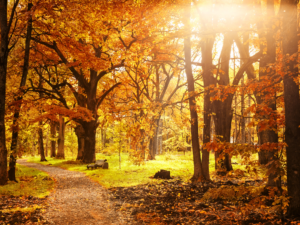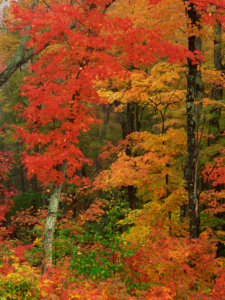The explosion of colours that greet us in fall is one of the reasons why it’s a favourite season for many people. But why do leaves turn colour in fall? To fully tell the tale of why the leaves on trees change from green to yellow, orange, red, and (sometimes) purple, we have to explain why leaves start as green!
Green Leaves
 The leaves produce nourishment for trees, providing most of the foods necessary for the tree’s growth. This food-making process takes place in the leaf in numerous cells containing chlorophyll, which gives the leaf its green colour.
The leaves produce nourishment for trees, providing most of the foods necessary for the tree’s growth. This food-making process takes place in the leaf in numerous cells containing chlorophyll, which gives the leaf its green colour.
Chlorophyll is an amazing chemical – it absorbs energy from sunlight, using it to transform carbon dioxide from the air and water from the ground into sugars, starches, and other carbs. It also gives leaves their bright green colour.
Within each green leaf are yellow and orange pigments, too. These are chemicals like carotenes, which you may know as what makes carrots orange. During the spring and summer, chlorophyll production is so strong that the green overshadows the rest of these colours.
In Fall, Chlorophyll Breaks Down
 Trees know fall is on its way when the days get shorter and the temperature starts to change. When they detect the changes, their leaves stop making food, and as a result, the green chlorophyll breaks down. As the green dissipates, the yellow and orange colours in the leaves become visible and give the leaves some of their fall splendour.
Trees know fall is on its way when the days get shorter and the temperature starts to change. When they detect the changes, their leaves stop making food, and as a result, the green chlorophyll breaks down. As the green dissipates, the yellow and orange colours in the leaves become visible and give the leaves some of their fall splendour.
When different amounts of chlorophyll residue mix with other pigments in the leaf during the fall, it can create many beautiful hues. The fall foliage of some trees only shows yellows; others, like oak trees, present brown colours. Other chemical changes can occur, creating more colours; for instance, leaves can develop red anthocyanin pigments. Some mixtures instigate purple, especially in trees like dogwoods and sumacs; others give the sugar maple its brilliant orange.
Many factors influence the colours: temperature, light, and water supply determine the degree and the duration of the fall colours we love so much. For instance, lower temperatures instigate the formation of more anthocyanin, creating bright reds in maple trees. The best times to enjoy the autumn colours are clear, dry, and cool days with above-freezing temperatures.
Why Do These Leaves Fall Off The Tree?
Another process occurs in most deciduous trees when the daylight shortens – where the stem of the leaf attaches to the tree, the tree develops a layer of cells, severing the tissue that supports the leaf. The tree also seals the “cut”; when the leaf falls from the tree, it leaves behind a scar. Your only job now is to rake them up!
Now that you know the science, you can appreciate the changing fall colours on the same level as a professional arborist. You should take advantage of the number of trees we have in London and enjoy the season in all its splendour!

